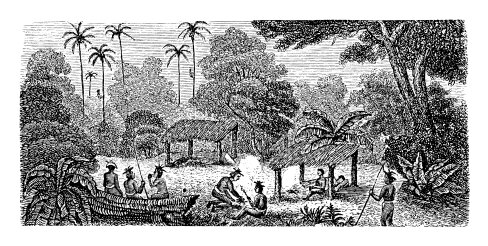The territories which shape today’s Republic of Equatorial Guinea did not have historical ties prior to the establishment of trade enclaves and the subsequent colonisation by European powers. The Pygmy populations, and the Bubis after them, settled on the Island of Bioko around the fifth century. The Island of Corisco was occupied by Benga clans. The continental region was inhabited by diverse sociocultural groups, including the Fang, Bisio and Ndowe (with the latter divided among a number of clans, including the Batangas, Mienes, Bengas, Combes, Balengues, Bapukues, Ones, Basekes and the Buikoo), all of them of Bantu descent. The Island of Annobon remained uninhabited until the 15th century when it was visited by Portuguese sailors which settled a population from the present-day Angola as well as some Sephardic Jews expelled from Spain.
Precedents to the creation of Equatorial Guinea
During the 15th, 16th and 17th centuries, the region was principally explored and exploited by Portugal and Holland. In 1641, the Italians arrived on the Island of Annobon, and the Portuguese lost control of it in 1730.
After the treaties of San Ildefonso (1777) and el Pardo (1778), Spain came to theoretically govern the islands of Bioko (then referred to as the Island of Fernando Pó) and Annobon. It created the Government of Fernando Pó and Annobon which was dependent on the Viceroyalty of the Río de la Plata until its dissolution around 1810. The United Kingdom settled in Bioko at the beginning of the 19th century, and Annobon remained without any Spanish intervention. From 1843, Spain again took over the government of the islands, and in 1845 Queen Isabel II of Spain arranged for the transfer to Bioko of all blacks and free mulattoes from Cuba who voluntarily wished to do so. However, 1861 saw the forced relocation of almost 300 black Cubans.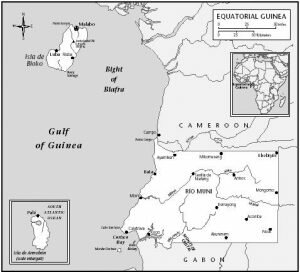
In the continental region, the Gulf of Guinea was then settled by trade ports of various countries, which were then joined by some Spanish posts around the estuary of the Muni and Benito rivers. These areas then became a Spanish protectorate in 1885 and later the Colony of Rio Muni in 1900 following an agreement with France which determined the limits of both countries’ recognised territory in the Gulf region. At the same time, Spain created the Colony of Elobey, Annobon and Corisco for the islands of Elobey Grande, Elobey Chico, Annobon and Corisco, which together with the Government of Fernando Pó for the Island of Bioko, shaped the three administrative areas. These areas were autonomous from one another, and were governed under Spanish rule.
During this period, clashes took place between the colonial power and the indigenous population reluctant to colonisation, resulting in the Bubi revolt of 1910, and the 1918 punitive expedition in Rio Muni.
Creation of Equatorial Guinea
Colony of Spanish Guinea (1926-1959)
Modern Equatorial Guinea emerged in 1926 when Spain merged all of its colonies in the Gulf of Guinea, creating the so-called Colony of Spanish Guinea, and developing large-scale cacao plantations on the Island of Bioko. These plantations had thousands of Nigerian workers imported as farm labourers.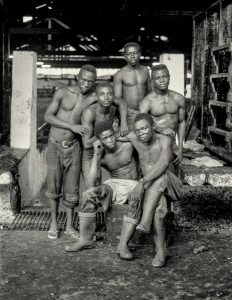
During the Second Spanish Republic, no significant changes were made in the Colony. By September 1936 the Spanish Civil War had already begun, and military garrisons on the Island of Bioko joined the rebel military while the continental region remained faithful to the Republic. The rebels eventually took control of the entire colony.
In the following decades, the colony remained stable, though the liberation of Ethiopia in 1941, the independence of Libya in 1951 and, most importantly, that of Ghana in 1957 impelled an embryonic nationalist and pro-independence sentiment.
Provinces of the Spanish Equatorial Region (1959-1963)
In 1959, the island and the continental region of the Colony acquired the status of Spanish provinces, adopting the designation of the Spanish Equatorial Region. The first local elections (within the system of “organic democracy” of the Franco regime) were held in 1959 wherein the first Equatoguinean officials were elected to the courts.
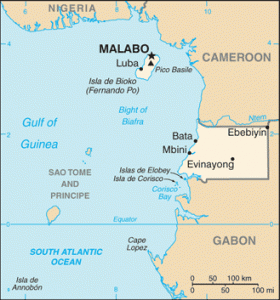 Numerous initiatives to initiate an independent court were brought forth—chiefly, the Popular Idea of Equatorial Guinea, known by its initials IPGE, created by exiled Equatoguinean nationalists in Cameroon after the country’s independence in 1960, and partially financed by the government in Yaoundé. Its political plan initially included the integration of Equatorial Guinea’s continental region into the Cameroonian state. The National Liberation Movement of Equatorial Guinea (MONALIGE) was created in 1954 by exiles in Gabon, as well as the Popular Liberation Union of Equatorial Guinea (UPIGE), organised in Libreville with the support of the Gabonese Government under Leon Mba after the country’s independence in 1960.
Numerous initiatives to initiate an independent court were brought forth—chiefly, the Popular Idea of Equatorial Guinea, known by its initials IPGE, created by exiled Equatoguinean nationalists in Cameroon after the country’s independence in 1960, and partially financed by the government in Yaoundé. Its political plan initially included the integration of Equatorial Guinea’s continental region into the Cameroonian state. The National Liberation Movement of Equatorial Guinea (MONALIGE) was created in 1954 by exiles in Gabon, as well as the Popular Liberation Union of Equatorial Guinea (UPIGE), organised in Libreville with the support of the Gabonese Government under Leon Mba after the country’s independence in 1960.
Autonomous Community of Equatorial Guinea (1963-1968)
In December 1963, Spain put forth an autonomy referendum to the people of the Equatoguinean provinces which was approved by an overwhelming majority. As a result, these territories were endowed with autonomy, officially adopting the name of Equatorial Guinea.
The Autonomous Community was led by Bonifacio Ondo Edu who returned to Equatorial Guinea after the approval of the Statute of Autonomy, and transformed the UPIGE to the Movement for the National Unity of Equatorial Guinea (MUNGE).
In November 1965, the United Nations approved a draft resolution which called on Spain to ensure the date for Equatorial Guinea’s independence as soon as possible. In December 1966, the Spanish Council of Ministers agreed to prepare the Constitutional Conference. In October 1967, this Conference began.
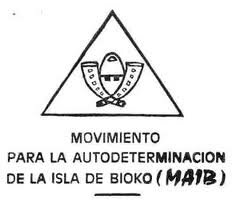 A new Bubi Union emerged in 1967, further to the majority nationalist current which sought the creation of a new state and the minority which supported the integration of Equatorial Guinea into Cameroon. The Bubi Union later changed to the Movement for the Self-Determination of the Island of Bioko (MAIB) which demanded the establishment of an independent state in Bioko, thus cutting all dependency links with the rest of Equatorial Guinea. That same year, the Fernandina Democratic Union was founded, made up of the Fernandinos (or Krios), descendants of black populations which settled on the Island of Bioko at the beginning of the 19th century, mainly from Liberia, Sierra Leone and Ghana, but also from the Spanish Caribbean islands.
A new Bubi Union emerged in 1967, further to the majority nationalist current which sought the creation of a new state and the minority which supported the integration of Equatorial Guinea into Cameroon. The Bubi Union later changed to the Movement for the Self-Determination of the Island of Bioko (MAIB) which demanded the establishment of an independent state in Bioko, thus cutting all dependency links with the rest of Equatorial Guinea. That same year, the Fernandina Democratic Union was founded, made up of the Fernandinos (or Krios), descendants of black populations which settled on the Island of Bioko at the beginning of the 19th century, mainly from Liberia, Sierra Leone and Ghana, but also from the Spanish Caribbean islands.
The Republic of Equatorial Guinea
On 11 August 1968, the country approved a popular referendum for the Constitution of Equatorial Guinea, and in September elected Francisco Macías Nguema Ndong Biyogo as the country’s first president. The Government also consisted of prominent politicians like Edmundo Bossió and Atanasio Ndong Miyono, among others. Finally, the official proclamation of the Republic of Equatorial Guinea took place on 12 October 1968.
The early days of the country’s sovereignty witnessed great
strain due to various diplomatic conflicts with Spain, as well as the growing authoritarianism of Macías.
The gradual establishment of the dictatorship
The future already began to take shape in 1970 with the creation of the United National Workers Party (PUNT) and the carrying-out of political repression by the Government. Then 7 May 1971 saw Macías sign a decree which granted him all direct powers of the Government, suspending the Co
uncil of the Republic and abolishing several articles of the 1968 Constitution.
In July 1972, a new set of laws was enacted which allowed Macías to become president for life, conferring upon him the titles of “Honourable and Great Comrade”, “Major General of the National Armies”, and “Grand Master of Education, Science and Culture”.
Constitution of 1973

After the adoption of the Constitution of July 1973, the PUNT was enshrined as the sole party, and Macías as the state’s absolute leader.
The Regime of Francisco Macías
This period saw a string of purges within the Cabinet of the Government as part of the executive’s efforts to dismantle attempts to carry out a coup d’état. The Macías Government also carried out repeated human rights abuses, resulting in the disappearance of several leaders of the political opposition.
The overthrow of Francisco Macías
The coup d’état of August 1979, led by Lieutenant Colonel Teodoro Obiang ended the regime of Francisco Macías Nguema Ndong Biyogo.
Between 1979 and 1982, the country was led directly by Teodoro Obiang and allied members of the military, with the Constitution remaining suspended.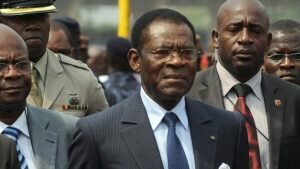
Constitution of 1982
The Government of Teodoro Obiang
In August of 1982, a new Constitution was approved by referendum, establishing a presidential government, assisted by a Council of State which includes the President of the Chamber of Representatives, the President of the Supreme Court and the Defence Minister, although the country remained governed by a Supreme Military Council until 1987.
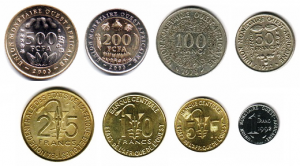 In 1983, legislative elections were held, but boycotted by numerous political groups. In 1985, the country joined the economic area of the CFA Franc. In 1986, the first attempt at a coup d’état against the Government came to light, after which the Democratic Party of Equatorial Guinea (PDGE) was founded in 1987 from the old Supreme Military Council. All other political parties were banned at this time.
In 1983, legislative elections were held, but boycotted by numerous political groups. In 1985, the country joined the economic area of the CFA Franc. In 1986, the first attempt at a coup d’état against the Government came to light, after which the Democratic Party of Equatorial Guinea (PDGE) was founded in 1987 from the old Supreme Military Council. All other political parties were banned at this time.
The coup attempt in May of 1986
At the end of May in 1986, the Government made public an aborted coup attempt. Sergeant Venancio Mikó, one of the main people involved, took refuge in the Embassy of Spain in Malabo, requesting political asylum.
A dozen military leaders, all belonging to the Fang ethnic group, and more specifically to the clan in Mongomo, were detained—among them Lieutenant Pablo Obama Eyang. The amount of detainees amounted to around 100.
Minister of Information, Isidoro Eyi Monsuy, was the first to announce that the situation was under control. In order to report on the coup attempt, Lieutenant Marcos Mba Obando summoned the accredited media in Malabo on 23 May 1986. The Government accused various members of the political opposition to be involved in the plot, which led to the forced or voluntary exile of a good part of the opposition to Spain and France.
Constitution of 1991
After the approval of a new Constitution, the country established French as a second co-official language.
Another coup attempt took place in March 2004 at the hands of Simon Mann. Mann was originally sentenced to 7 years in prison for his involvement in the attempt. In 2009, however, Mann was granted “a complete pardon on humanitarian grounds” by Pre

